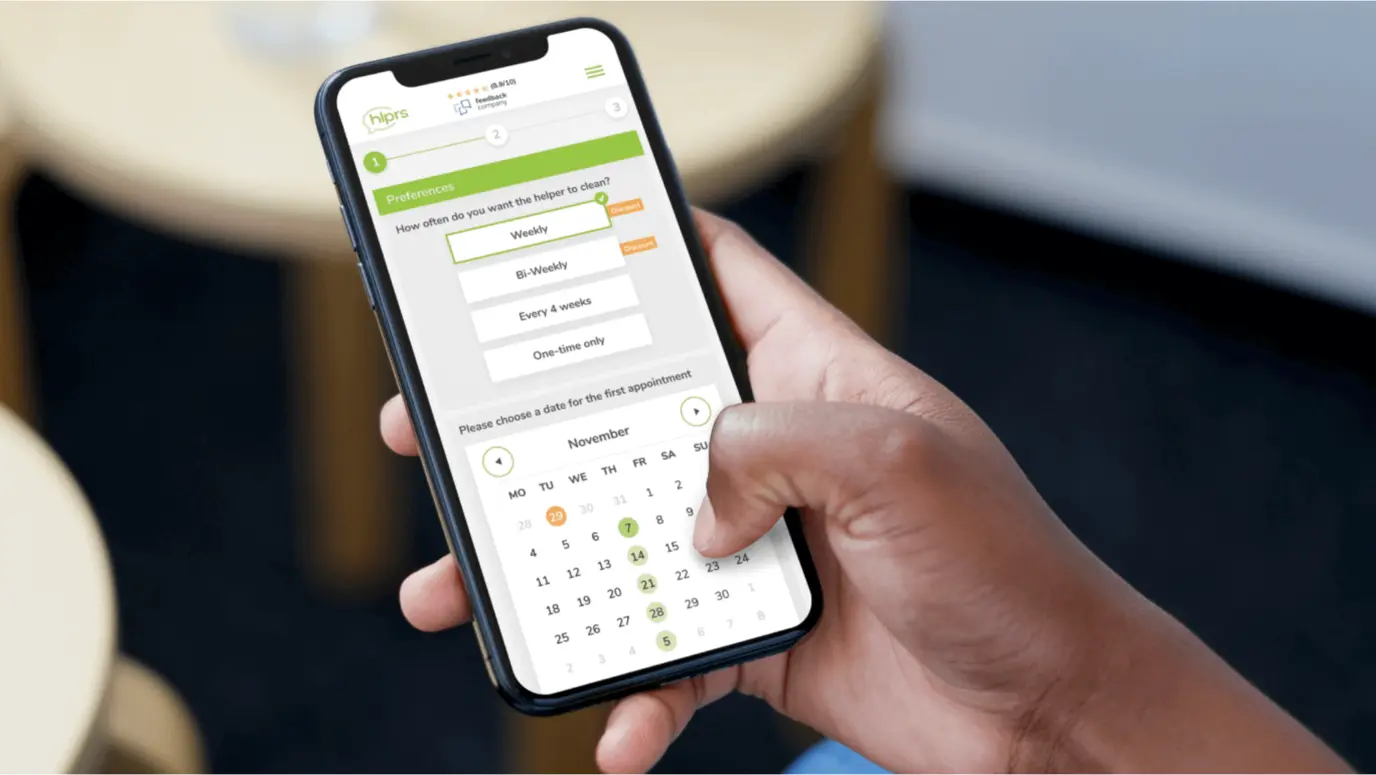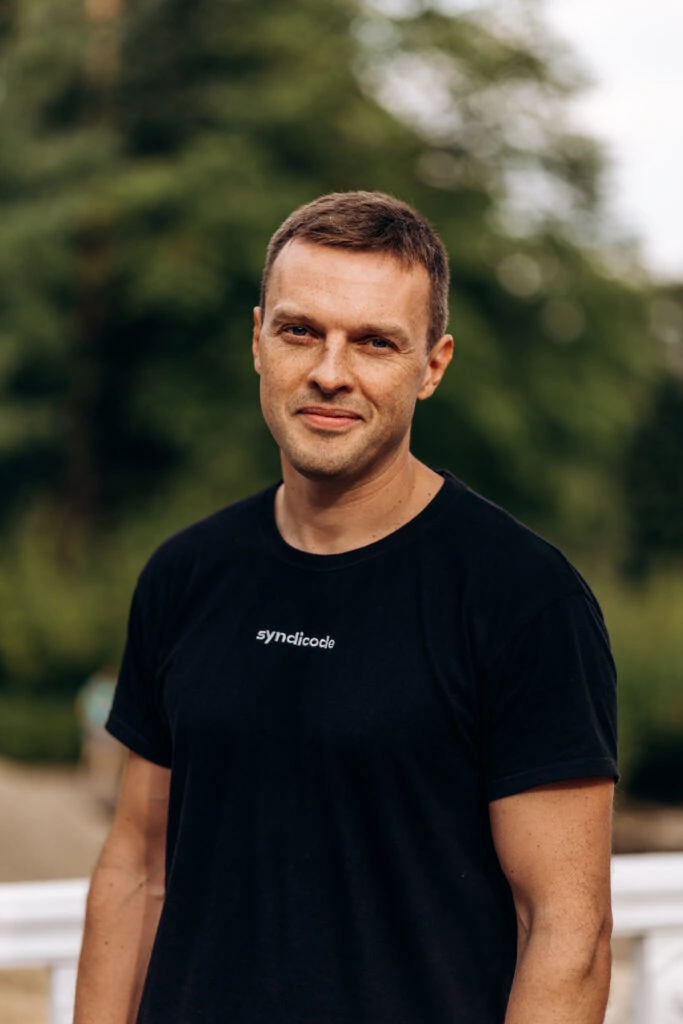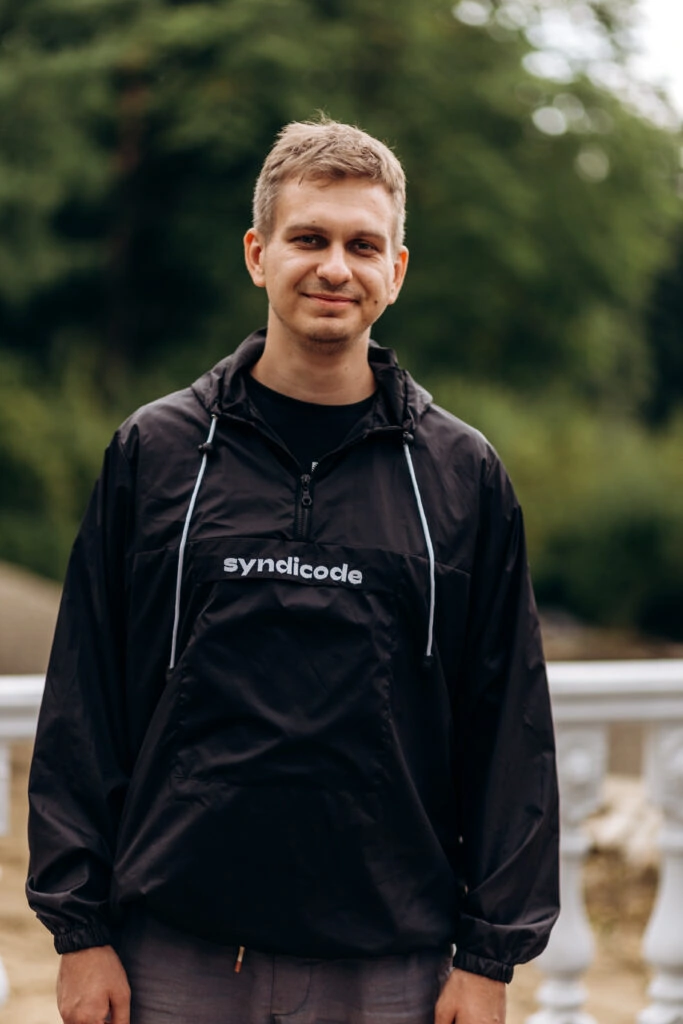4.9 on Clutch
Custom Software Development Services
Syndicode specializes in providing custom software development services tailored to meet your unique business needs. From dynamic web and mobile applications to cutting-edge AI & ML integrations, our team of skilled developers ensures the delivery of solutions that drive results.
Services We Offer
At Syndicode, we offer a comprehensive range of custom software development services to help businesses of all stages and sizes. Our expertise spans multiple areas, ensuring we have the skills to bring your vision to life.
-
Web Development
We create robust and scalable web applications using the latest technologies. Whether it’s a corporate website, eCommerce platform, or a complex enterprise solution, our web development team ensures performance, security, and a seamless user experience.
-
Mobile Development
Our mobile app development services provide cross-platform solutions for iOS, Android, and hybrid apps. We focus on delivering user-centric mobile applications that enhance engagement and offer high performance on all devices.
We Also Help Innovate
Stay ahead of the competition with our custom software development services. From AI & ML to cloud-native development, we leverage cutting-edge technologies to drive automation, optimize performance, and transform your business operations for long-term success.
-
AI & ML
Syndicode delivers AI and ML solutions, including NLP, computer vision, and big data analysis. With expertise in Python and TensorFlow, we build custom AI systems to automate workflows, enhance decision-making, and boost efficiency, helping businesses unlock smarter, data-driven operations.
-
SaaS
Syndicode provides comprehensive SaaS services, including development, integration, and multi-platform management. Leveraging AWS, Azure, and Google Cloud, we deliver scalable, secure, and cost-efficient solutions, enabling businesses to innovate and grow with flexible, reliable infrastructure.
-
DevOps
Our DevOps services enhance collaboration, automate testing, and accelerate deployment cycles. Using Kubernetes and Docker, we streamline development pipelines, enabling faster, more reliable software delivery and optimized operations for businesses seeking agility and shorter time-to-market.
Need a custom software solution?
Syndicode creates tailored software to meet your unique business needs, from initial concept to final deployment. Fill out a short form to start the development.
Contact usOur Process
-
Discovery
In the discovery phase, we work closely with you to understand your business needs, goals, and technical requirements. This involves analyzing your challenges, gathering insights, and defining the project scope. We identify key stakeholders, understand target users, and clarify expectations, ensuring alignment on the project’s objectives. By thoroughly assessing your requirements, we ensure our custom software development services are tailored to address your unique challenges and goals. This stage ensures we deliver a solution that is both relevant and impactful, setting the stage for successful development.
-
Planning
During the planning phase, we define detailed technical requirements, create a project timeline, and allocate resources. This phase is crucial for aligning expectations and ensuring the smooth execution of our custom software development services throughout the process. Milestones, tasks, and deliverables are broken down to ensure transparency and accountability. This stage often includes setting up collaboration tools and methodologies such as Agile or Scrum, depending on the project.
-
Development
During the development phase, our team of skilled developers begins building your software solution. As a caring software development service provider, we use the latest technologies and frameworks to write clean, efficient code, adhering to best practices. This phase includes front-end and back-end development, API integration, and database management, ensuring your software is functional, scalable, and secure. Regular check-ins and agile methodologies allow for flexibility, ensuring the product evolves as your business needs change. We maintain open communication throughout this phase, giving you insights into progress and incorporating feedback as needed.
-
Testing
In the testing phase, we rigorously examine the software for functionality, security, and performance. We conduct various testing methods, including unit testing, integration testing, and user acceptance testing, to identify and resolve bugs or issues. Our QA team ensures the software meets quality standards, works flawlessly across platforms, and provides a smooth user experience. Testing is critical to ensuring reliability, scalability, and security, guaranteeing the final product is stable and ready for launch. This step minimizes risks and ensures a successful deployment.
-
Deployment
The deployment stage involves launching the software into your live environment. As part of our tailored software development services, we ensure a smooth transition from development to production, minimizing downtime and ensuring the system is fully operational. Our team handles all aspects of deployment, including server configuration, code deployment, and environment setup. We also provide training for your team and ensure proper documentation is in place. Post-deployment, we monitor the software closely to ensure it performs as expected and resolves any immediate issues that arise.
-
Support
In the support phase, we provide ongoing maintenance and updates to keep your software running optimally. This includes bug fixes, performance enhancements, and ensuring compatibility with new technologies. Our team monitors the system, addressing any issues that arise and making necessary improvements to ensure long-term success. We offer scalability support as your business grows, ensuring your software adapts to changing needs. In addition, you can hire our custom software development consulting services to ensure that your software remains secure, functional, and aligned with your business objectives well beyond its initial deployment.
Current tool not fitting your needs?
Syndicode will design a custom solution tailored specifically for your business requirements.
Get startedTailored Solutions for Every Business
-
Large businesses
Our custom-built software services help large businesses enhance operational efficiency and integrate seamlessly with existing systems. Our solutions are designed to support complex business processes and ensure smooth digital transformation. With our expertise, large enterprises stay competitive and drive long-term growth.
-
Small & Medium Businesses
Our custom software development services provide small and medium businesses with affordable, tailored solutions. These solutions are built to improve productivity, streamline workflows, and support sustainable growth. We help SMEs compete more effectively and grow in their respective industries.
-
Startups
We partner with startups to bring innovative, scalable software solutions to life. Our agile development approach ensures fast iterations, allowing startups to launch quickly and adapt to market changes. With our support, startups can turn their ideas into reality and grow rapidly.
Technologies We Work With
-
Front-end
-
Back-end
-
Mobile
-
Databases
-
Cloud and DevOps
-
AI & ML
-
Version control
Need to speed up development?
Our agile team delivers high-quality software quickly, without compromising on functionality. Let us help you accelerate your project and meet tight deadlines.
Contact usOur Engagement Models
-
End-to-end Product Development
With our custom software development services, we manage the entire product lifecycle, from concept to deployment. This model is ideal for businesses seeking a full-service partner to handle design, development, testing, and support.
-
Dedicated Team
Our custom software development services include providing a fully committed development team that works exclusively on your project. This is perfect for businesses needing long-term collaboration, flexibility, and complete control over the development process, without the hassle of hiring and managing internal staff.
-
Staff Augmentation
We offer staff augmentation services to enhance your existing team with specialized, skilled talent. This model provides the flexibility to scale your team quickly, filling in critical skill gaps while maintaining control over your project. It’s an efficient solution for short-term or specific expertise needs.
Our Industry Expertise
Syndicode combines deep industry knowledge with technical expertise in custom software development service delivery. Our versatile tech stack, agile methodologies, and skilled team enable us to address the unique challenges and goals of diverse industries.
-
Ecommerce
We build e-commerce platforms, personalized customer experiences, and inventory management systems to enhance online sales and streamline operations.
-
Healthcare
Syndicode provides custom healthcare solutions like patient management systems, telemedicine platforms, and health data analytics, ensuring better care and efficiency.
-
Education
We create e-learning platforms, virtual classrooms, and school management systems, helping educational institutions provide interactive and effective learning experiences.
-
Finance
We develop secure fintech solutions including payment gateways, banking software, and trading platforms, empowering financial institutions to innovate and optimize services.
-
Logistics
Syndicode develops fleet management, route optimization, and supply chain automation systems, enhancing operational efficiency and reducing costs in logistics.
-
Retail
We provide custom retail solutions such as POS systems, inventory management, and customer loyalty platforms, driving sales and improving customer engagement.
-
Real Estate
Syndicode engineers build property management software, CRM systems, and virtual tour solutions, enabling real estate businesses to manage operations efficiently.
-
Entertainment
Syndicode delivers streaming platforms, content management systems, and audience analytics tools to enhance user experience and maximize content monetization.
Struggling with outdated software?
Your business deserves modern, efficient software that scales with your growth. Syndicode will develop a custom solution that integrates seamlessly and enhances productivity.
Let’s talkWhy Choose Syndicode?
Syndicode is a trusted partner for custom software development services, offering technical expertise, a proven track record, clear communication, flexibility, security, and ongoing support. Our commitment to delivering innovative, secure, and scalable solutions ensures we meet your business needs, however complex.
-
Technical expertise
Our team excels in a wide range of technologies, from frontend frameworks to backend development, cloud, and DevOps. We stay ahead of industry trends and continually enhance our skills. You’ll always receive innovative, high-performance custom software development services tailored to your specific business requirements and technological environment.
-
Proven track record
Syndicode has successfully delivered numerous projects across various industries, including healthcare, fintech, and e-commerce. Our experience and portfolio showcase our ability to provide personalized software development services, meet deadlines, exceed client expectations, and deliver reliable, scalable solutions that drive long-term success and growth.
-
Clear communication
We prioritize keeping you informed and involved at every stage of the project, ensuring you stay in control. With regular updates, feedback sessions, and clear reporting, you’ll always know the project’s status, which reduces miscommunication and ensures a smooth, transparent collaboration for optimal results.
-
Flexibility
Our agile development approach ensures we adapt to your evolving needs, offering flexible custom software development services. Whether your project requires changes, resource scaling, or timeline adjustments, we offer flexibility and responsiveness. This way, we deliver solutions that support your business goals and keep you competitive.
-
Security
We prioritize security at every development stage, using best practices like encryption, secure code standards, and vulnerability testing. Our custom software development services are compliant with industry regulations and protect our clients against potential threats, safeguarding their business and customer data.
-
Ongoing support
After deployment, we provide continuous support and maintenance to ensure your software runs smoothly. Our company offers bug fixes, performance updates, and feature enhancements. Your solution stays updated, secure, and aligned with your growing business needs.
Our Team
-
 Dmytro CEO
Dmytro CEO -
 Tetiana Lead HR
Tetiana Lead HR -
 Oleksandr Software Engineer
Oleksandr Software Engineer -
 Oleksandr Software Engineer
Oleksandr Software Engineer
Why Outsource Bespoke Software Development?
Outsourcing custom software development with Syndicode gives you access to specialized expertise and rapid delivery. No extra costs or delays that come with managing an in-house team. You receive high-quality, custom software development services tailored to your business needs.
-
Specialized expertise
Our team includes skilled developers, designers, and project managers with deep expertise in your industry and technologies. By outsourcing custom software development services to us, you gain access to a broad skill set that’s difficult to find in-house. As a result, your software is impeccable and fully meets your standards.
-
Cost efficiency
Custom software outsourcing to Syndicode helps reduce the costs associated with hiring, training, and maintaining an internal development team. We offer scalable resources and pricing models that fit your budget. You receive top-tier software solutions without the financial burden of managing a full-time team.
-
Fast delivery
Our agile development process, combined with a dedicated, experienced offshore team, allows us to deliver projects quickly and efficiently. By partnering with us, you benefit from faster time-to-market, ensuring your software is deployed on schedule, and helping you stay ahead of the competition.
Frequently asked questions
-
What is custom software development?
Custom software development is the process of creating tailored software solutions specifically designed for custom business software development needs. Unlike off-the-shelf software, custom solutions are built from the ground up to address specific workflows, challenges, and objectives. This approach ensures that the software integrates seamlessly with existing systems, scales as your business grows, and enhances operational efficiency. At Syndicode, we specialize in delivering custom software that aligns perfectly with your goals, ensuring you get a solution that maximizes value and performance for your business.
-
How much does custom software cost?
The cost of custom software product development services depends on the project’s complexity, scope, and unique requirements. To provide an accurate estimate, we need details about your project, including its features, technology stack, design specifications, and required integrations. Schedule a discovery meeting with us, and we’ll deliver a tailored estimate. We offer flexible pricing models to fit your needs and can customize our approach to meet your budget. Client satisfaction remains at the core of everything we do.
-
How long does a software development project take?
The duration of a custom software development project depends on various factors, such as its complexity, scope, features, and integrations. Simple applications may take a few months, while more complex custom software development solutions, like enterprise platforms, can take up to a year or longer. At Syndicode, we use the discovery phase to assess your project’s needs and establish a clear timeline based on those requirements. This approach allows us to accurately plan and deliver high-quality solutions within your desired timeframe, ensuring the project stays on track and aligned with your business goals.
-
What types of custom software are there?
At Syndicode, we most frequently receive requests for custom application development services, enterprise software, CRM systems, e-commerce platforms, and specialized solutions like healthcare management or financial services software. Our projects often include integrations with existing systems, APIs, or third-party services. Share your vision and requirements with us, and we’ll help transform them into a tailored solution that addresses your specific business challenges and boosts overall performance.
-
How is custom software different from off-the-shelf solutions?
Custom software is specifically built to meet the unique needs of a business, offering personalized features, scalability, and seamless integration with existing systems. Off-the-shelf software, by contrast, is pre-built for general use and may not address specific workflows or adapt to growing business requirements. While off-the-shelf solutions are faster to implement, software application development services provide greater flexibility, scalability, and the ability to evolve with your business. At Syndicode, we develop tailored solutions to ensure that your software perfectly aligns with your operational goals and future growth.
-
What software development methodologies do you use?
For end-to-end software development solutions, we primarily follow agile and Scrum methodologies. Agile development emphasizes iterative progress, flexibility, and client collaboration. It works perfectly for continuous feedback and improvements throughout the project. Scrum, a framework within agile, organizes the process into short development cycles, called sprints, ensuring the timely delivery of features. We also use Kanban for projects requiring real-time updates and flow management. These methodologies help us stay flexible as your needs change while keeping a clear and organized process. This ensures we deliver high-quality, timely, and effective custom software development solutions that meet your goals.
-
How are communication and project management handled at Syndicode?
Syndicode ensures seamless communication and project management with clear, consistent updates and a collaborative approach. As part of our software development outsourcing services, a dedicated project manager is assigned as your primary point of contact, keeping you informed at every stage. Regular meetings, progress reports, and feedback sessions ensure you’re always involved and in control. By using tools like Jira, Trello, and Slack, we track progress, share updates, and enable real-time communication. This approach ensures transparency of our end-to-end software development services, efficient workflows, and alignment with your goals. As a result, you maintain control over the project and always know what’s happening and when.








